












this
page intentionally left blank
SECTION TWO: COMMERCIAL DEVELOPMENT
Part One: Introduction
I. Purpose and Intent
It
is acknowledged that commercial development that is out of scale, poorly
designed, or of low quality can undermine the character of the community, and
is less likely to succeed economically over the long term. Too often, site planning and building design
of new commercial development does not adequately take into consideration a
project’s setting within the community and its contribution to the urban
streetscape. Also, traffic circulation
is usually a primary design consideration, while pedestrian issues are
frequently an afterthought.
Design
standards and guidelines offer a vision for a different approach to commercial
design, an approach that can be beneficial both to developers and to the
community. Design standards and
guidelines emphasize key design concepts such as, but not limited to, creating
a “sense of place” within the development and along the public streetscape;
designing at a pedestrian-scale; creating visual interest; providing pedestrian
connectivity within developments and with adjacent sites; and ensuring that the
overall aesthetic character of new developments are compatible with the
established character of surrounding neighborhoods.
Having
design standards and guidelines in place is also another mechanism of a
community’s comprehensive plan. Horizon 2020, the
comprehensive plan for the City of
The purpose of these commercial design standards and guidelines is
to:
q
articulate community design principles, guidelines, and standards for
commercial development within the City of
q
enhance the community’s overall value and appearance;
q
improve the overall quality and promote well-designed projects;
q
ensure compatibility with surrounding neighborhoods;
q
enhance pedestrian safety and walkability; and
q
improve user-friendliness and predictability in the design review
process.
Because
it is recognized that design professionals, including architects, landscape
architects, and land planners, are trained to strive for creative excellence,
the design criteria established herein are not intended to restrict creative
solutions.
II. Applicability of Standards and Guidelines
Unless otherwise exempted below, the following development
activities in which site plan approval is required are subject to design
review: 1) all new commercial
development and 2) any re-development of an existing commercial area, including
addition of new floor area to an existing building and changes to the exterior
appearance of a facade visible from a public right-of-way. Additional standards and guidelines may also apply
where a neighborhood plan or special area plan has been created.
Design review is not
required when site plan review is not required.
Additionally, commercial developments subject to review under the City of Lawrence
Downtown Design Guidelines or under guidelines adopted as part of an Urban
Conservation Overlay District are not subject to these commercial design
standards and guidelines Further,
commercial developments subject to review under Kansas Statues K.S.A. 75-2715 thru
75-2725, as amended (Kansas Historic Preservation Act) and Chapter 22 of the
City Code (Conservation of Historic Resources Code) are not subject to these
commercial design standards and guidelines.
The
standards and guidelines are in addition to the regulations contained in the
City’s Land Development Code. They will
be used in reviewing projects to determine conformity with the overall
community design objectives and consistency with the community’s comprehensive
plan, Horizon 2020, and any adopted neighborhood or special area
plan. Where the provisions of this
design manual conflict with provisions in the Land Development Code or adopted
nodal, neighborhood, or special area plan, the more restrictive provision shall
apply.
The
degree to which each standard and guideline applies to a development project
will be evaluated on a case by case basis in an effort to achieve an overall
design that meets the purpose and intent of the commercial design standards and
guidelines. Because the City of

III. How to Use This Document
A. Design
Elements
The
standards and guidelines for commercial development are broadly categorized in
two areas – 1) site planning and design and 2) aesthetic character and building
design. Each of these categories is
further broken down into specific design elements. The discussion below covers the range of
design elements addressed by the standards and guidelines and explains the
importance of each element in creating commercial development and building
stronger neighborhoods.
Site Planning and Design:
Site planning and design
considers a development’s organization on a specific site and its relationship
to adjacent development. Utilizing sound
site planning and design principles can minimize a development’s impacts on
adjacent development with properly sited buildings, better designed parking
areas, adequate pedestrian connections and access; and the retention of
existing trees. Elements of site
planning and design take into consideration the integration and enhancement of
existing natural features; stormwater and site drainage patterns; the streetscape and transitions with
surrounding neighborhoods; vehicular and pedestrian circulation patterns;
landscaping and screening patterns; and lighting and security concerns.

Aesthetic Character and Building Design:
Aesthetic character and
building design considers a development’s visual quality and its relationship
on the community’s imaginability.
Principles of aesthetic character and building design are intended to
visually tie a commercial development together, not only internally with other
buildings of the same development but also externally with adjacent
development. Elements of aesthetic
character and building design include general building design and design
context; articulation of building facades and exterior walls; emphasizing building
entryways and rooflines; providing architectural details that create pedestrian
interest; utilizing building materials and colors that are unifying; and
integrating building and site signage into the overall composition.

B. Framework
This
design manual sets forth specific design criteria that are organized in a
format that contains design principles, guidelines, and standards. Each subsection contains the following
components, which should be applied as discussed.
Purpose
and Intent Statement:
This
is a broad statement(s) explaining the design intent for the standards and guidelines
that follow. They should be used to help
interpret the application of a standard and/or guideline in a specific
situation. In cases where special
conditions exist that are not specifically addressed, the intent statement
should serve as the basis for determining the appropriateness of the proposed
design.
Standard and Guideline
Statements:
These
are statements that help distinguish whether the proposed criteria is a
standard or a guideline. Standards are
the mandatory minimum requirements. Guidelines are advisory statements intended to go “above and beyond” what is minimally required
or to allow more flexibility where a rigid requirement would not be feasible. The standards in this document use the word
“shall.” while the guidelines use the word “should.” Regardless of which term is used, each
standard and guideline must be addressed.
The City will expect to see how the design of a project has responded to
each standard and guideline.
The
“shall” or “must” statements offer relatively little flexibility, unless
choices are provided within the statements themselves. However, the “should,” “recommended,” or
“encouraged” statements offer greater flexibility and indicate that the City is
open to design features that are equal to, or better than, those stated - so
long as the intent is satisfied. The
applicant has the burden of proof to demonstrate how a proposed design satisfies
the standards and appropriately addresses the guidelines. This determination will be made by the
Planning Director.
Illustrations:
The pictures, drawings,
and diagrams in this document are intended to illustrate the intention of the
individual standards and guidelines.
They are not intended to illustrate the only or even the best way to
meet the minimum requirements. These graphic examples are
meant to be examples, and are not the only acceptable means to accomplish the
intent of this design manual. Applicants
and project designers are encouraged to consider designs, styles and techniques
not pictured in the examples that fulfill the intention of the design standards
and guidelines.
The
commercial design standards and guidelines are not intended to set a particular
style of architecture or design theme.
Rather, they encourage the establishment of a greater sense of quality,
unity, and conformance with the community’s urban form. It is also important to note that the
standards and guidelines are not intended to slow or restrict development, but
rather to add consistency and predictability to the development review process.
IV. The Design Review Process
The design review process authorizes the Planning Director to review
certain development applications for conformance with adopted design standards
and guidelines. Design review actions
performed by the Planning Director shall be considered administrative and shall
not require public notice or hearing.
If required hereby, no site plan application or development
plan application approval shall be issued until design review approval has been
obtained. Development permits shall be
consistent with the design review approval.
Minor adjustments may be made after review and approval by the Planning
Director. Adjustments shall be limited
to minor changes in the dimensions or siting of improvements or to design
details that do not change the scope or character of the proposal.
A. Procedure
Pre-Submittal Meeting:
A pre-submittal meeting is required for all projects subject to design
review prior to the submission of a development application, unless waived by
the Planning Director upon good cause shown by applicant. The purpose of the pre-submittal is to
provide the applicant and city staff the opportunity to discuss a proposed
project, review design and development standards, and discuss the design review
process.
The pre-submittal meeting may occur concurrently with the pre-submittal
required for site plan review. At the
pre-submittal meeting the applicant shall have available a conceptual site
plan(s) and information to demonstrate how the project satisfies the standards
and addresses the guidelines.
Neighborhood Meeting:
A neighborhood meeting is required to
be conducted by the applicant prior to submittal of a design review
application. This requirement may be
waived by the Planning Director upon request by the applicant for projects the
Director determines to be minor.
Application Submittal Requirements:
In addition to the submittal
requirements outlined in this secion, the Planning Director shall establish
submittal requirements and forms to be used for applications. A complete application shall consist of the
completed application form with all required information and any filing fee (as
established by the City Commission).
Decision:
A decision on a development application for a
project subject to review shall be made by the Planning Director, and shall approve,
conditionally approve, or deny the application. The decision of the
Planning Director shall be issued in writing.
Appeal:
Any party aggrieved by the decision of
the Planning Director may file an appeal in accordance with the provisions and
procedures for appeals set forth in Sec. 20-1311 of the Land Development Code.
Part Two: New Commercial Development
I. Site Planning and Design

The
following standards and guidelines are intended to encourage an orderly and
logical pattern of commercial development that instills a sense of place and
that enhances the livability of the community.
It is also the intent that the standards and guidelines encourage
forethought and consideration of both a development's external relationships,
as well as its internal organization, to improve convenience and efficiency for
users of commercial development. Site
layout and building orientation often define the focus of activity within a
commercial development that often occurs at the front door or along the
street. The standards and guidelines are
intended to promote sound site planning and design practices for commercial
development to:
q
Encourage, establish, and maintain a unique and identifiable image for
commercial development in the City of
q
Create
a cohesive visual identity, a sense of place, and an attractive streetscape for
users and passers-by.

q
Ensure that building layout relates appropriately to surrounding developments
and streets.
q
Ensure that site circulation promotes contiguous, efficient, and safe
pedestrian and vehicle circulation patterns.
q
Ensure that parking areas provide safe and efficient access to
buildings, but do not dominate the overall site design

A. Natural Features
Purpose and
Intent:
Mature
trees and open lands, rolling topography, streams and natural drainageways are
a few of the elements that contribute to the distinct character of
It
is also the intent of this section to protect important natural processes and
ecological functions, such as natural stormwater drainage, air purification,
and provision of shade. Site disturbances and construction
activities, including extensive grading or unusual site improvements (i.e.,
large retaining walls), that “force-fit” a preconceived design onto a
particular piece of property is strongly discouraged. Modifying the design of a commercial
development to adapt to the site typically results in a reduced potential for
environmental problems and an improved level of visual interest and variety. New commercial development should work to
preserve significant natural features that contribute and enhance the local
character of the community through sensitive site organization and minimal site
disturbance.
Standards
and Guidelines:
Natural Features
1. Site planning and design should utilize the opportunities
and reflect the constraints created by floodplains, slopes, soils, vegetation
and other physical features.
incorporating
an existing tree into the site design
2. Berms,
channels, swales, and similar man-made changes to the landscape shall be
designed and graded to be an integral part of the natural landscape and to
provide a smooth transition in changes of slope. The maximum slope of any man-made slope shall
be three-to-one (3:1).

3. Retaining walls shall comply with the
requirements for retaining walls set forth in Section I (G) 35-38 of these standards
and guidelines.
Existing
Vegetation
4. Vegetation
and plant material that exists on a site prior to its development is encouraged
to be used to satisfy landscaping standards, including street tree
requirements, provided that it meets the size, variety, and locational
requirements of Article 10 (Landscaping and Screening) in the Land Development
Code. As part of the site plan
submittal, applicants shall submit an
existing tree survey and preservation plan to show compliance with these
standards and guidelines and the LDC.
5. On sites with existing, mature trees of
acceptable species and appropriate location, at least twenty percent (20%)
shall be preserved or transplanted on site.
For purposes of these standards, “mature” trees include the following:
a. deciduous trees with six inch (6”)
minimum caliper;
b. evergreen trees six feet (6’) or more
in height; or
c. groups or stands of five (5) or more
trees with a minimum caliper of four inches (4”).
6. For every one inch (1”) of tree caliper
of a tree designated to be preserved that is removed or substantially damaged
during clearing, grading, or construction, the developer shall replace the
removed or damaged tree with two inches (2”) of replacement tree caliper. Replacement trees shall be the same or
similar species to the trees removed or damaged, or alternately a species
native to
integrating an open-air drainage system as a focal
point within the development
7. Existing
vegetation, such as native grasses, hedgerows, or non-mature trees that are in
appropriate locations, in sufficient quantities, and of acceptable quality to
be used to fulfill transition landscaping or buffering requirements of these standards
and guidelines shall be preserved.

B. Stormwater
and Site Drainage
Purpose and
Intent:
Site
drainage systems, including detention basins, have traditionally been designed
from a pollution control and stormwater runoff perspective due to the
requirements of Phase II of the National Pollutant Discharge Elimination System
(NPDES). While controlling contaminants and runoff from
urban development is important, commercial developments are strongly encouraged
to integrate storm drainage systems, especially open-air drainage channels,
basins, and detention areas, into the site design as focal points or other
prominent feature of the development whenever possible. This is especially important when such
features will be visible from public rights-of-way and internal pedestrian
walkways.
example showing an enhanced natural drainageway as
part of the development’s stormwater drainage system
Additionally,
existing natural drainage patterns,
stream corridors, and wetlands are strongly encouraged to be enhanced and
incorporated into the overall storm drainage system of the development. Using existing drainage features (that have
been improved and enhanced) helps improve water filtration, groundwater
recharge, and pollutant absorption while minimizing the increase in runoff as a
result of new development. To further
maximize this benefit, the design of open-air drainage systems should consider
the use of larger, consolidated basins
over multiple, smaller ones.

Standards and Guidelines:
Natural Drainageways
example
showing how to incorporate an open-air detention area as a focal point to
the development
1. Improved
drainage systems with a tributary area of eighty (80) acres or more shall be
designed and constructed as open, vegetated channels, with the intention that
these areas provide restored natural habitat and require minimal landscape
maintenance. Open channels shall be
planted with native grasses, forbs, shrubs and trees. Culverts, walls, structural liners or other
similar constructed systems shall be used only where necessary to cross
roadways or to meet engineering standards for channel stability.

Storm
Drainage and Detention Areas
2. Drainage patterns, including the design and location of downspouts,
shall be designed to prevent concentrated surface drainage from collecting on,
and flowing across pedestrian walkways.
3. Detention
basins and open drainage areas visible from public rights-of-way and internal
pedestrian walkways shall be incorporated into the site design as an attractive
amenity or focal point, such as a site entryway feature, a public green/open
space, or a transition technique with adjacent development. Such areas are strongly encouraged to be
designed as part of the site landscaping network.
traditional
auto-oriented strip development with parking at the street (top) vs.
pedestrian-oriented development with buildings & amenities at the
street & parking in the interior of the site (bottom)
4. When fencing is provided for open drainage
and/or detention areas, it shall be a decorative material that coordinates with
other elements on the site, such as stone or brick columns. Fencing shall be open to allow views into and
across the featured detention area.

C. Streetscape and Neighborhood Transitions
Purpose and
Intent:
Typical
tools for making the transition between commercial development and other, less
intensive land uses have included back-to-back building orientation, set
distances between uses, and heavily-landscaped buffer areas, often with fences
and walls. However, some of the
unintended results of this include excessive land consumption and lack of
pedestrian and vehicle accessibility.
Accordingly, the following design standards and guidelines have been
established to
ensure that new commercial developments are woven into the physical fabric of
the community and surrounding neighborhoods by recommending that building
placement and orientation provide compatible transitioning techniques to
minimize adverse impacts such as noise, odor, light, and glare. When
considering a transitioning technique, it is important to make certain that new
commercial development, where practicable, provides convenient, continuous, and
well-defined pedestrian and vehicle connections to adjacent development and
neighborhoods.
defining the street edge – pedestrian-oriented
development vs. auto-oriented development

The
standards and guidelines are also rooted in the concept that streetscapes are
the community’s most visible public spaces.
Streets play a pivotal role in determining both resident and visitor
experiences and, to a great extent, help to define the character of the
community. The standards and guidelines
recommend that buildings within new retail developments, especially out-lot or
pad site buildings, be pulled forward to define the edges of public streets and
internal private drives. It is also
recommended that buildings located at intersection corners be oriented in a
manner that addresses both streets. This
emphasis on streetscape and defining the “edge” helps to create a genuine
“sense of place” along the streets of the community and within individual developments.

traditional auto-oriented strip development with
parking at the street (top) vs. pedestrian-oriented development with
buildings & amenities at the street & parking in the interior of
the site (bottom)
The
standards and guidelines also encourages the presence of, or the appearance of,
smaller retail stores to promote walkability and a pedestrian-oriented commercial
development by creating variety, breaking up large expanses of exterior walls,
expanding the range of the site's activities, and helping to define the
streetscape. When buildings are located
closer to streets, the scale of the development is reduced, pedestrian traffic
is encouraged, and architectural details take on added importance.

Standards
and Guidelines:
Building Orientation
1. Strictly linear or "strip commercial" development patterns
shall be unacceptable.
2. A minimum of sixty percent (60%) of the
development site's street frontages shall be occupied by the following:
example showing how to use pad site buildings to
frame the street & providing areas of interest at the site entrance
a. building
frontage, which shall be a minimum of twenty-five percent (25%) of the street
frontage unless the following applies:
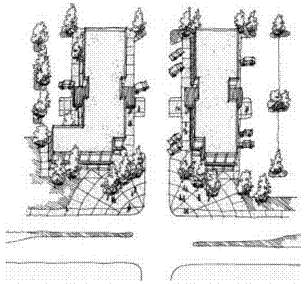
(i) for arterial streets, this standard
shall not apply if the primary building is within one hundred feet (100’) of
the public right-of-way.
(ii) for collector streets, this standard
shall not apply if the primary building is within one hundred sixty-five feet
(165’) of the public right-of-way;
b. decorative architectural walls (no less
than thirty inches [30”]);
c. landscaped entryway signage or
features;
d. focal point; and/or
e. site amenities.
f. the remaining street frontage may be
occupied by parking areas, as limited by those requirements set forth in these standards
and guidelines, or by breaks for vehicle or pedestrian access.
3. Within each intersection quadrant,
primary buildings and/or pad site buildings shall be arranged to orient to the
intersecting streets and to frame the corner at that street intersection.
4. New buildings shall be organized to
align with existing buildings located across the intersecting streets in a way
that “completes" the space around the corner and unites the adjacent
developments.
example
showing how to “complete the space” at an intersection with complimentary
building form & orientation
5. In the event of very steep upward grades along the street
frontage, decorative treatment shall be required. The use of retaining walls and landscaping
shall conform to Section I (G) 35-38 of these standards and guidelines.
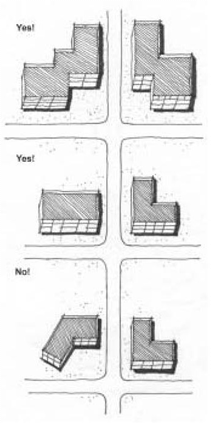
6. In multiple-building developments, the
number, location, and design of independent pad sites shall reinforce, rather
than obscure, the identity and function of the commercial development.
7. Pad sites shall be clustered together
to define street edges and entry points, to enclose and create interesting
places between buildings, and to increase the ease of pedestrian movement
between buildings.
8. Even dispersal of pad sites in a
widely-spaced pattern within the development, even if along the street edge(s),
is discouraged.
9. All kiosk-type buildings and structures
shall be integrated with the overall development, and shall be subject to the
same requirements as all other buildings within the development.
a. free-standing kiosks and drive-up ATM
structures shall not be located along the primary street frontage.
b. access to a freestanding kiosk or
drive-up ATM structure shall be from drive aisles internal to the development and
not from the adjacent public streets.
c. free-standing kiosks and drive-up ATM
structures shall comply with the aesthetic character and building design
standards and guidelines.
Neighborhood
Compatibility
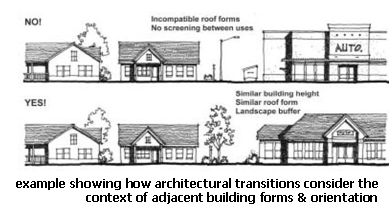 10. Commercial
development shall incorporate architectural transitions, green/open space
transitions, and lesser intensive uses as transitions before employing more
traditional landscaping and screening transitions.
10. Commercial
development shall incorporate architectural transitions, green/open space
transitions, and lesser intensive uses as transitions before employing more
traditional landscaping and screening transitions.
11. The combination of architectural
transitions, green/open space transitions, and operational compatibility
standards should work to reduce the need for more intensive landscaping and
screening transitions.
12. Operational compatibility standards
shall apply to all commercial development, regardless of type of transition
technique used
a. architectural transitions:
commercial development shall employ a minimum of two (2) of the following
techniques to ensure compatibility with surrounding development:
(i) use similar building setback if similar
massing exists;
(ii) use similar building height if similar
massing exists;
(iii) use similar roof form if similar massing
exists;
(iv) mitigate the larger mass of commercial
buildings with facade articulation; or
(v) use front-to-front building
orientations, especially with commercial uses that are pedestrian-intensive
(i.e., restaurants, banks).
(vi) other building-to-building orientations
may be utilized except that a back-to-front building orientation is not an
acceptable transition tool.
b. green/open space transitions:
commercial development shall employ one (1) or both of the following techniques
to ensure compatibility with surrounding development:
(i) green spaces, courts, squares, parks,
plazas, and similar spaces that can also function as community gathering
places; or
(ii) existing natural features, including
natural differences in topography (not retaining walls), streams and
drainageways, existing stands of trees, and similar features.
(iii) When existing natural features are used
as transitions, adequate pedestrian connections to adjacent land uses be
provided.
example of a typical landscaping & screening
transition between non-residential & residential development
c. lesser
intensive uses as transitions: when office, small-scale retail,
pedestrian-intensive retail, civic, or public uses are planned as part of the
same development containing more intensive commercial uses, the development
shall site the lesser-intensive uses or more community-serving uses as
transitions to lower-intensity, adjacent uses.
For example, post offices, banks, and restaurants (all of which are
pedestrian-intensive, community-serving uses) should be sited next to adjacent
medium-density residential uses.

d. landscaping and screening
transitions: where other transitions tools are not possible, or where other
transition tools by themselves do not create an adequate transition to, or
buffer from, less intensive land uses, landscaping and screening transitions
used shall comply with these standards and guidelines. When necessary to further assure an adequate
buffer between the commercial development and an adjacent use, fences and walls
meeting the requirements of these standards and guidelines may be used in
combination with landscaping and screening.
Fences and walls next to pedestrian walkways shall be no higher than
four feet (4’) unless otherwise stated in these standards and guidelines.
e. operational compatibility: New
commercial development will be operationally compatible with existing
neighborhoods and uses, including, but not limited to, the following:
(i) placement of trash receptacles;
(ii) location of delivery and loading zones;
and
(iii) placement and illumination of outdoor
vending machines.
Neighborhood
Connectivity
example
of a well-defined pedestrian connection into a development
13. When
fencing is provided along a property line, a decorative fencing material and
architectural accents shall be used which are compatible with the building
design. Fencing shall be designed in a
manner to create variety such as staggering the fence line and incorporating
wrought-iron and masonry columns.

14. Pedestrian connections, including
bicycle access, into the commercial development shall be clearly defined and
continuous.
D. Vehicular Access and Parking Areas
Purpose and
Intent:
example
of a development having clearly defined site entrances & internal drive
aisles
The
role of cars in everyday life and the need to provide adequate and convenient
space for them is recognized. However,
this necessity contributes to the typical suburban pattern of predominant and
highly-visible parking areas within commercial developments that place large
amounts of parking between the front door of buildings and the adjacent
street. As a result, this development
pattern contributes to a formless arrival experience for users, and creates a
detached relationship between the primary building and the street. It is also recognized that vehicular access
and circulation patterns are often uncoordinated, which results in driver
confusion and the potential for vehicle-pedestrian conflicts.

Contrary
to this type of development pattern, vehicular access and circulation that is
designed and coordinated (in a traditional “grid” pattern for example) often
helps increase driver predictability and minimizes vehicle-pedestrian
conflicts. Having a coordinated
vehicular access and circulation system can also help in the redevelopment of
commercial areas as businesses change over time
Furthermore,
parking areas that are arranged around (to the rear and side) large buildings
provide safe, convenient, and efficient access, result in shortened distances
to other buildings and public walkways, reduce the overall scale of the paved
surfaces within the development, and improve the visual character from the
public street and right-of-way
Standards
and Guidelines:
General Considerations
1. A detailed circulation plan, showing
both vehicular and pedestrian patterns, shall be submitted with all development
applications that show compliance with these standards and guidelines. Distinction shall be made between pedestrian,
bicycle, transit, and vehicle circulation patterns.
example of a typical development pattern with no
relationship to adjacent streets/drive aisles
2. Unless
otherwise stated below, vehicular access and off-street parking areas shall
comply with Article 9 (Parking, Loading, and Access) of the Land Development
Code (LDC).

External Circulation and Access
example of a typical development pattern with no
relationship to adjacent streets/drive aisles
3. The
number and location of vehicle entrances to a commercial development shall be
consistent with the existing or anticipated design of adjacent streets. The
specific location of primary vehicle shall be determined by the following
factors:

a. location of existing or planned median
breaks;
b. separation requirements between the
entrance and major intersections;
c. separation requirements between other
entrances and minor intersections;
d. need to provide shared access with
adjacent development;
e. need to align with previously approved
or constructed access points on the opposite side of the street; and
f. minimum number of entrances needed to
move traffic onto and off the site safely and efficiently.
4. The design of driveway approaches, medians, and islands shall include
an angle of ninety degrees (90o) or greater at the corners or
intersections to permit ease of vehicular movement around corners and to
minimize the amount of unusable space
for landscaping or other site amenities.
example of a preferred development pattern with a
stronger relationship to adjacent streets/drive aisles
5. Direct
vehicular access from arterial streets is strongly discouraged, but may be
permitted if that access from an arterial street improves the overall traffic patterns on the street
network adjacent to the development.

6. No more than one (1) full access point
may be granted to an arterial street, however, additional limited access points
may be granted.
7. Connections with adjacent nonresidential
development shall be provided by siting a logical array of minor access points
with such development.
a. common or shared service and delivery
access shall be provided between adjacent parcels and/or buildings.
b. access easements may be required to
ensure that pad sites or adjacent parcels have adequate access in the event
ownership patterns change over time.
Internal
Circulation
8. A clear system of continuous main
circulation drives shall be established to carry the highest volumes of traffic
within the site and to create an internal vehicle circulation pattern that
provides a clear and direct access to outlying pad sites and to each parking
area.
a. to reduce pedestrian and vehicular
conflicts in large commercial developments, main drive aisles shall not be
located along the facades of buildings that contain primary customer entryways
unless separated from the building facade by a row of parking.
example
of a development having service & delivery areas separated from parking
& pedestrian areas
i. It is recommended that drive aisles along a building’s primary
entryway facade incorporate design elements similar to a residential street,
including walkways, lighting, landscaping, and defined crosswalks to minimize
conflicts between vehicles and pedestrians.

b. in small commercial developments or in
areas of larger developments where the location of access points and the
configuration of the main drive aisles indicate that traffic volumes are lower
and, consequently, pedestrian-vehicular and vehicular-vehicular conflicts are
less likely, more flexibility is available in the location and design of
internal drive aisles.
c. internal intersections shall have
adequate sight lines, design geometrics, and/or traffic controls to minimize
accident potential.
accessible
parking spaces must be located adjacent to & provide direct access to
walkways & customer entryways
9. New
commercial development should provide loading and delivery facilities separate
from customer parking and pedestrian areas that comply with Article 9 (Parking,
Loading, and Access) of the LDC.

Parking Areas
10. In the design of parking areas, safe, convenient, and efficient
pedestrian access to building entryways is strongly encouraged and parking
provided should meet, not exceed, expected demand of the commercial
development.
11. Parking areas are also encouraged to use shared parking
facilities whenever practical to do so.
12. It is recommended that public transit needs to be integrated into
the overall circulation design in a manner that minimizes conflicts with normal
traffic flow of the development.
example
of a parking area layout having spaces along the building facade &
pedestrian connections from the building to the public r.o.w.
13. Parking
areas should be accessed from rear and/or side drive aisles to minimize front
of store conflicts between vehicles and pedestrians.

14. Where applicable, shopping cart return
stations shall be evenly distributed within and between separate parking
blocks, and should be identified on the final plan.
a. shopping cart return stations should
incorporate landscaping, architectural features, or similar design elements to
draw attention to and soften the impact of stand-alone features within parking
areas.
15. Accessible parking spaces shall be
located adjacent to walkways and at building entryways to minimize
pedestrian-vehicle conflicts.
16. Where a commercial development proposes
to exceed the minimum number of parking spaces required, at least fifty percent
(50%) of those additional spaces shall be constructed of a permeable surface,
as approved by the City Engineer. This
requirement may be waived if additional interior parking area landscaping is
provided equal in area to the number of permeable parking spaces otherwise
required.
enhanced streetscape with amenities such as
landscaping, lighting, signage, & wide walkways
17. Parking spaces may be permitted along main drive aisles and
along the facades of buildings featuring customer entryways provided such
parking does not impede access for fire and emergency vehicle or access to and
from the development (i.e., driveways and turning movements).

18. The use of angled parking spaces within parking areas is discouraged
and should be avoided to help minimize confusion associated with one-way drive
aisles and potential conflicts between vehicles.
E. Pedestrian Access and
Amenities
Purpose and
Intent:
an internal green space & water feature
oriented to the pedestrian user
Wide
walkways and connectivity are two simple design concepts that should be incorporated
into new development. Wider pedestrian
walkways, enhanced with landscaping, benches, lighting, and other amenities,
offer comfort and safety for pedestrians, and create a more walkable and
inviting shopping environment. Walkway
connections allow for pedestrian movement within the development and with
surrounding areas. Creating shopping
areas that are interesting and integral to the development’s design (instead of
creating stand-alone, detached sites) and invoking a “sense of place” includes
providing space for people to sit, relax, and interact. A public space need not be expansive or
elaborate to serve its purpose. The key
to a successful public space is that it be located at a focal point within the
development, such as a customer entryway or other high-pedestrian use or
visibility area.

example showing a pedestrian circulation plan
Pedestrian
accessibility and activity opens auto-oriented developments to the
neighborhood, reducing traffic impacts and enabling the development to foster a
more inviting image. Important
considerations include buildings offering attractive and inviting pedestrian-oriented
features, spaces, and amenities; site entrances and parking areas configured to
be functional and inviting with walkways conveniently tied to logical
destinations; transit stops and drop-off/pick-up points integrated into site
configuration; and pedestrian walkways anchored by special design features such
as towers, arcades, porticos, pedestrian light fixtures, bollards, planter
walls, public art, and other architectural elements that define circulation patterns
and outdoor spaces.
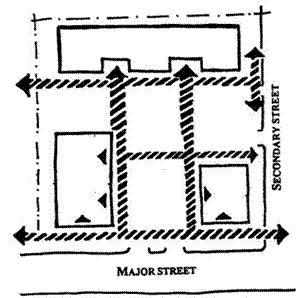
It
is the intent of the standards and guidelines to ensure that new commercial
developments are designed for the pedestrian, including bicycles and public
transit, and to create public walkways and internal pedestrian circulation
systems that provide user-friendly pedestrian access, safety, shelter, and
convenience. Design of the pedestrian
circulation system and amenities must also consider accessibility from the
viewpoint of those with special needs or physical disabilities. It is also the intent of the standards and
guidelines that walkways and amenities provided in a commercial development be
clearly defined, functional, and enjoyable to use.
example
showing useful walkway connections

Standards
and Guidelines::
General Considerations
1. A detailed circulation plan, showing
both pedestrian and vehicular patterns, shall be submitted with all development
applications that show compliance with these standards and guidelines. Distinction shall be made between pedestrian,
bicycle, transit, and vehicle circulation patterns.
Pedestrian
Circulation
2. All internal pedestrian walkways of the
commercial development shall be not less than eight feet (8’) in width unless
otherwise noted in these standards.
Pedestrian walkways shall include clear sight lines to building entryways.
3. Pedestrian walkways shall be designed
to provide direct access and connections to and between the following:
a. customer entryways to each commercial
building, including pad site buildings;
use of
special paving where walkways cross a drive aisle or parking area
b. any
walkways on adjacent properties that extend to the boundaries shared with the
commercial development;

c. any public walkway system along the
perimeter streets adjacent to the commercial development;
d. adjacent land uses and developments,
including but not limited to adjacent residential developments, retail shopping
centers, office buildings, or restaurants;
e. adjacent public parks or other public
or civic uses including but not limited to schools, places of worship, public
recreational facilities, or government offices; and
f. site amenities, focal points, or
gathering places.
4. Pedestrian walkways shall be provided
along the full length of any building, including pad site structures, along any
facade featuring a customer entryway and along any facade abutting public
parking areas.
5. Except where features such as arcades
or entryways are part of the facade, such walkways shall be separated from the
facade of the building to provide planting beds for foundation landscaping.
6. Pedestrian walkways shall provide
weather protection features, such as awnings, arcades, or roof overhangs along
the building façade and extending outward a minimum of thirty feet (30’) from
all customer entryways.
7. Connections between the internal
pedestrian walkway network and any public sidewalk system located along
adjacent perimeter streets shall be provided at regular intervals along the
perimeter street as appropriate to provide easy access from the public sidewalk
to the interior walkway network.
an internal green space, water feature, &
seating areas oriented to the pedestrian user
8. Where applicable, for
walls and fences greater than one hundred fifty feet (150’) in length, convenient
and inviting pedestrian access from the commercial development to the
surrounding neighborhood shall be provided breaks.

9. At each point that the internal
pedestrian walkway system crosses a parking area, drive aisle, or driveway, the
walkway or crosswalk shall be clearly marked through the use of special paving
or a change in paving materials distinguished by their color, texture, or
height to enhance pedestrian safety, comfort, and wayfinding.
10.
Pedestrian
Amenities
example showing how to incorporate a focal point at
the corner of a street intersection
11. All
site amenities within a commercial development shall be an integral part of the
overall design and within easy walking distance of primary buildings, major
tenants, and any transit stops.

12. Site amenities shall not be constructed
of materials that are inferior to the principal materials of the building and
landscape.
13. Site amenities shall be contiguous and
concentrated in one (1) or two (2) locations, rather than scattered in small,
unusable portions of the site.
14. It is preferred that site amenities be
in close proximity to the main entryway of the building to take advantage of
the flows of pedestrians, but other locations may be considered if they are
visible and easily accessible to the public.
pedestrian seating areas, enhanced with
landscaping, encourages pedestrian activity
15. Each
development having five thousand (5,000) square feet or more of lot area or
five thousand (5,000) square feet or more of building area shall provide at
least one (1) public space according to the following formula: One Percent (1%)
of the Lot Area + One Percent (1%) of the Building Area = Minimum Amount of
Public Space Required

a. a site amenity may qualify as a
required green/open space transition, provided the site amenity meets all
applicable requirements for such transition as stated previously in these design
standards and guidelines.
b. the amount of area devoted to
satisfying this requirement may be deducted from the amount of space otherwise
devoted to parking area interior landscaping.
16. On each corner of a street intersection,
commercial developments shall provide a "focal point" within a two
hundred foot (200’) radius from the intersection of the centerlines of the two
(2) streets.
17. A "focal point" shall be
visible from the intersecting streets and shall be either:
example
showing how pedestrian-scaled lighting can be used to enhance &
reinforce walkways
a. a
distinctively-designed building, which may include a pad site building,
preferably with a vertical element, but shall not include automobile service
stations;

b. an architectural feature that is a
minimum of twenty-five feet (25’) tall and a maximum forty-five feet (45’) tall
(i.e., a clock tower, spire, or interesting roof form);
c. public art or sculpture of visible
size and scale;
d. fountains or other water feature;
e. public plazas or other open space;
f. landscape feature; or
g. stormwater detention area of
appropriate design.
18. Use of site furnishings, such as
benches, tables, bike racks, and other pedestrian amenities shall be provided along
main pedestrian walkways and at building entryways, plazas, and other
pedestrian areas.
19. Site furnishings used shall not block
pedestrian access to main walkways, open space areas, and/or building
entryways.
unacceptable
integration or screening technique
20. Bicycle
parking areas shall be located adjacent to customer entryways and shall comply
with Section 20-913(g) of the LDC.

21. Pedestrian connections shall be
reinforced with pedestrian scale lighting, bollard lighting, accent lighting,
or a combination thereof to aid in pedestrian way-finding.
acceptable
integration or screening technique
22. Location
of transit stops and other public transit amenities shall be coordinated with

F. Outdoor Storage, Sales, and Service Areas
Purpose and
Intent:
Seasonal
sales, loading, service, trash collection, and storage areas exert visual and
noise impacts on surrounding neighborhoods.
These areas, when visible from adjacent development or public streets,
should be screened, recessed, and/or enclosed.
While screens, recesses, and enclosures can effectively mitigate these
impacts, these areas also need to be integrated into the overall development
design to help further minimize potential adverse impacts.
preferred
integration or screening technique
It
is the intent of the standards and guidelines to de-emphasize from the public
perspective loading, service, trash collection, and storage areas; to
coordinate and integrate the location and architectural style of loading,
service, trash collection, and storage areas as a component of the overall
building(s) placement and design; and to minimize conflicts and unnecessary
adverse impacts with surrounding properties and/or the public street and
right-of-way.

Standards
and Guidelines:
Integration with Adjacent Development
example showing mechanical equipment screening
technique
1. Outdoor
storage, trash collection or compaction, loading docks, truck parking, utility
meters, HVAC equipment, and other service functions shall be oriented toward
on-site service corridors so that the visual and acoustic impacts of these
functions are fully contained and out of view from adjacent properties and
public streets. Service function areas
shall not face any residential district, unless no other location is possible.

unacceptable location for mechanical equipment
2.
Appropriate locations for loading and outdoor storage areas include areas
between buildings, where more than one building is located on a site and such
buildings are not more than forty feet (40’) apart, or on those sides of
buildings that do not have customer entryways.

3. In the design of delivery, service, and
trash collection areas, such areas should have sufficient area to minimize
conflicts with normal traffic flow of the development.
4. Service function areas shall not be
located within twenty feet (20’) of any public street, public walkway, or
internal pedestrian walkway.
seasonal sales areas must be permanently defined in
a manner that is consistent with other elements of the development’s design
5. No
delivery, loading, trash removal or compaction, or other such operation shall
be permitted between the hours of 10:00 p.m. and 7:00 a.m. unless the
development submits evidence that sound barriers between all areas for such
operations effectively reduce noise emissions to a level of 45 db, as measured
at the lot line of any adjoining property.

Integration
with Site Development
6. When it is not feasible to locate
mechanical equipment and utility areas within a building, such equipment and
areas shall be located and screened in a manner so as not to be visible or
heard from adjoining properties.
effective use if landscaping helps visually tie a
development together & improves the imaginability of that development
a. when
landscaping is used for screening purposes, evergreen species shall be used as
the primary planting. Landscape
plantings for wall-mounted meters must be installed at a height of six feet
(6’).

b. all
above ground electrical and/or telephone cabinets shall be placed within the
interior side or rear building setback yards.
c. Such
utility cabinets are prohibited within required front or corner side yards
adjacent to street right-of-way unless screened with landscape materials.
7. Non-enclosed areas for the storage and
sale of seasonal inventory and/or vending machines shall be permanently defined
and screened with landscaping, walls, and/or fences.
8. The height of stored or displayed
inventory shall not exceed the height of the screening wall or fence. All fences and/or walls shall comply with the
requirements set forth in these standards and guidelines.
9. Screening materials, colors, and
designs shall be the same as, or of equal quality to, the materials, colors,
and designs used for the primary building and landscaping.
landscaping
must be coordinated with lighting & other site features to avoid
conflicts
10. Exterior shopping cart storage areas located along a
building facade shall be permanently defined and screened with landscaping,
walls, and/or other architectural features.

G. Landscaping. Screening, and Walls
Purpose and
Intent:
Landscaping
is the adhesive that binds a building to its site and connects a development to
its surroundings. The effective use of
landscaping helps reduce the perceived scale and massing of larger retail
developments, adds visual interest to long building facades, emphasizes visual
prominence at corner sites, focuses views for both pedestrians and motorists, enhances
the visual appearance of parking areas, and increases the sense of neighborhood
scale and character. When used in
combination with fencing and berms, landscaping can also be utilized to enhance
and focus views and to screen and buffer less aesthetic portions of the site
from the public and adjacent properties. However, landscaping should not be the primary
technique used for buffering and screening of less intensive adjacent land
uses.
Standards and Guidelines:
General Considerations
1. Unless otherwise stated in these standards
and guidelines, landscaping shall comply with Article 10 (Landscaping and
Screening) of the Land Development Code (LDC).
Submittal of a landscape plan is required per Section 20-1001(d) of the
LDC.
landscaping
along the building facade helps soften the building mass & helps create
visual interest
2. Landscaping
must be used to visually tie a development together and be an integral part of
the overall site design. Landscaping
that is an afterthought for setbacks or leftover portions of the site is
unacceptable.

3. Each area required to be landscaped
shall be covered in live material. Live
material includes trees, shrubs, ground cover, flower beds, sod, and other
living plant materials.
4. Areas not covered in live material, not
to exceed twenty-five percent (25%) of the landscaped area, shall be covered by
woody mulch, other organic or inorganic mulch, rock mulch, or other natural
materials other than exposed gravel and aggregate rock.
5. Landscape design and species shall be
used to create visual continuity throughout the development.
6. Plant material shall consist of a
mixture of evergreen and deciduous trees and shrubs to provide visual interest
and disease and pest resistance.
7. Consideration should also be given to
planting large deciduous shade trees along south facing facades in an effort to
promote energy conservation and efficiency.
8. Plant
varieties shall provide year-round color, texture, and/or other special
interest and a minimum of one-third
(1/3) of the plantings shall be evergreen species.

9. Ground covers shall be predominantly evergreen varieties.
10. Required
landscaping shall be coordinated with the location of utilities, driveways, and
traffic clearance zones.
11. Landscaping shall be located an adequate distance away from utility
lines and easements to avoid damage when such lines are repaired or replaced.
12. Adequate provisions shall be made for
irrigation to ensure that plants within landscaped areas continue to be
successful over the long-term.
area of landscaping between the walkway &
building façade creates a feeling of comfort & security for
pedestrians; landscaping needs to be in scale with the building mass
13. Vegetation
and plant material that exists on a site prior to its development may be used
to satisfy the landscaping standards provided that it meets the size, variety,
and locational requirements in Article 10 (Landscaping and Screening) of the
LDC.

14.
Plant varieties used in
landscape design are recommended to include drought tolerant and native
species, especially where irrigation will not be provided.
15.
Xeriscape techniques are
also encouraged as part of the landscape design.
16.
It is also recommended
that landscape design consider safety and security.
17.
Landscaping should also be
in scale and compatible with the development and adjacent developments.
Site
Landscaping
19. Building foundations shall be planted
with ornamental plant material, such as ornamental trees, flowering shrubs and
perennials, and ground covers.
where walkways transect parking areas, the
provision of landscaping helps increase the comfort level of those using
the walkway
a. Planting
shall be massed and scaled as appropriate for the size and space it occupies.

i. landscaped areas shall be at least eight
feet (8’) feet in depth. A depth of at
least ten feet (10’) is encouraged.
ii. trees shall be planted at ratio of at
least (1) tree per forty linear feet (40’) of building frontage along any
facade of a large retail building that faces a public street, pedestrian
walkway, or other public areas (i.e., pedestrian plazas, patio/seating
areas).
iii. Trees are permitted to be clustered and
may be integrated into a pedestrian promenade or located in landscaped areas
directly abutting the building.
20. Driveways to the development site shall
be planted with ornamental trees, flowering shrubs and perennials, and ground
covers and shall be massed and scaled as appropriate for the driveway size and
space.
21. Landscaping shall "pull back"
to open view lines into the site and to create corner features.
example
showing a parking area layout having landscape strips & peninsulas
(instead of islands) & having clearly defined pedestrian walkways
22. Internal
pedestrian walkways shall feature adjoining landscaped areas that include
trees, shrubs, benches, flower beds, ground covers, or other such materials for
no less than fifty percent (50%) of the length of the walkway. One (1) canopy shade tree per fifty linear
feet (50’) of such walkway is required.

23. Landscaping, outdoor lighting, and site
signage need to be coordinated so conflicts that may pose hazards to pedestrians
and/or vehicles are minimized.
Parking
Area Landscaping
24. In addition to the requirements in
Article 10 (Landscaping and Screening) of the LDC, the following requirements
for interior parking area landscaping shall apply:
a. landscape islands and peninsulas shall
occupy at least one-hundred sixty (160) square feet of ground area.
example
showing bufferyard & screening techniques between non-residential &
residential developments
b. landscape strips between parking rows shall
be a minimum of ten feet (10’) in width.
When incorporating pedestrian walkways, such strips shall be a minimum
of eighteen feet (18’) in width to accommodate vehicular overhangs, the walk,
lights, posts, and other appurtenances.

c. Landscape
strips or medians shall include medium to large deciduous trees at a minimum of
one (1) tree every thirty linear feet (30’), in addition to other parking area
landscape requirements.
d. primary landscaping materials used in
parking areas shall be trees, which provide shade or are capable of providing
shade at maturity.
e. Shrubbery, hedges, and other planting
materials may be used to complement the tree landscaping, but shall not be the
sole means of landscaping.
f. Effective use of earth berms and
existing topography is also encouraged as a component of the landscaping plan.
g. individual landscaped islands may be
combined with other islands and/or landscaped strips to provide larger
landscaped areas within the parking area as long as the minimum landscaping
requirements (area and number) for interior parking area landscaping are
fulfilled.
25. In addition to the requirements in Article
10 (Landscaping and Screening) of the LDC, parking areas shall be landscaped and screened
from view of street rights-of-way with at least one
(1) of the following:
a. a solid masonry wall with a minimum
height of two feet (2’), a maximum height of three feet (3’), and a landscape planting area with a minimum width of five feet (5’)
located adjacent to the public right-of-way;
b. a berm with a
minimum height of two feet (2’), a maximum height of three feet (3’), and a
maximum three-to-one (3:1) slope. The berm
shall be located entirely on the property with the parking area and include a combination of coniferous and deciduous tree and shrub
plantings;
c. a low continuous landscaped hedge at
least three feet (3’) high, planted in a triangular pattern so as to achieve
full screening at maturity;
d. landscape plantings consisting of
eighty percent (80%) coniferous trees and eighty percent (80%) evergreen shrubs
and groundcovers; or
e. a combination of any of these methods.
26. Perimeter parking area landscaping may
be satisfied by required landscaped bufferyards [Article 10 (Landscaping and
Screening) of the LDC] where the locational requirements for a bufferyard
overlap with the perimeter parking area landscaping requirements.
Buffering and Screening
27. Where a bufferyard is required in a
commercial development, that bufferyard(s) shall meet the requirements set
forth in Article 10 (Landscaping and Screening) of the LDC.
example showing a fence that has been incorporated
as part of the overall design
28. All
trash collection areas and mechanical and utility equipment shall be screened
and buffered as required in these standards and guidelines (Outdoor Storage,
Sales, and Services Areas) and as set forth in Article 10 (Landscaping and
Screening) of the LDC.

Fences and Walls
29. Unless otherwise stated in these standards
and guidelines, the maximum height of a fence or screening wall shall be eight
feet (8’).
a. The maximum height of a solid fence or
screening wall within the required front setback shall be three feet (3’).
30. Raised planters shall not exceed a
maximum height of three feet (3’), unless all of the following are provided:
a. screen treatment does not create a
safety hazard;
b. portion of treatment that is above
three feet (3’) in height is a minimum of seventy-five percent (75%)
transparent (i.e., see-through metal railing, trellis, or other similar
treatment); and
c. portion of wall/landscape treatment
that is above three feet (3’) in height provides added visual interest, detail,
and character suitable to the character of the development.
d. chain link fencing shall not be
permitted to be used to screen or enclose parking areas along a public walkway.
31. Fences and walls shall be constructed of
high quality materials, such as decorative blocks, brick, stone, treated wood,
and wrought iron.
32. When fencing is provided along a
property line, a decorative fencing material and architectural accents shall be
used which are compatible with the building facades and shall be designed in a
manner to create variety such as staggering the fence line and incorporating
“windows” or areas of transparency.
example showing a terraced retaining wall
incorporating landscape features into its design
33. The
maximum length of

a continuous, unbroken, and uninterrupted fence or
wall plane shall be one-hundred fifty feet (150’). In this instance, breaks shall be provided
through the use of columns, landscaping pockets, transparent sections, and/or a
change to different materials. Breaks in
the length of a fence shall be made to provide for required pedestrian
connections to the perimeter of a site or to adjacent development.
34. Fences and walls shall
be set back at least six feet (6’) from the back edge of an adjacent pedestrian
walkway, and such setback area shall be landscaped with turf, groundcovers,
shrubs, and trees, using a variety of species to provide seasonal color and
plant variety. Fencing shall not exclude
use of hydrants or fire department connections or hydrants.
35. Retaining walls shall not exceed five
feet (5’) in height from the finished grade.
36. Terracing shall be limited to four (4)
tiers with the width of the terrace between any two (2) five foot (5’) retaining
walls being a minimum of four feet (4’) with a maximum slope of three-to-one
(3:1).
37. Terraces created between retaining walls
shall be permanently landscaped.
lighting
fixtures scaled to the pedestrian user help to increase comfort &
creates visual interest
38. Retaining
walls shall be stacked with natural stone, faced with stone or earth-colored
materials, or faced with a material compatible with the primary building
materials. Railroad ties, timber, and
gabion-type retaining walls are prohibited.

H. Lighting
and Security
Purpose and
Intent:
Lighting
within commercial development plays a critical role in the overall experience
of such development. Lighting not only
provides for increased security and visibility, but also contributes to the
design character of a project, and encourages extended hours of active use
Standards and Guidelines:
General Considerations
1. Unless
otherwise stated in these standards and guidelines, lighting shall comply with
Section 20-1104 (Outdoor Lighting) of the Land Development Code (LDC). Submittal of an outdoor lighting plan is
required whenever site plan review is required.
2. Lighting design is encouraged to provide attractive lighting fixtures
and layout patterns that contribute to a unified site and building design.
3. Exterior
lighting, including parking areas, should be architecturally integrated with
the building style, material, and color.
4. Lighting design is also recommended to provide exterior lighting that
promotes safe vehicular and pedestrian access to, from, and within the
development.
example
showing a variety of lighting techniques that can be used to enhance the
pedestrian environment of the development
5. Project lighting that provides adequate visibility and security for
customers and passersby should respect the scale and character of adjacent
development without creating an intrusion or nuisance effect for adjacent
properties, especially abutting residential areas.

6. Building-mounted lighting shall be used
to highlight specific architectural features or at primary customer or building
entryways for safety and visual access.
7. Building
mounted light fixtures should be for aesthetic and safety purposes only and not
for general site illumination.
8. Building-mounted neon lighting is
allowed only when recessed, or contained in a cap or architectural reveal.
9. Lighting must be flush-mounted or
encased to minimize light trespass and glare.
10. Outlining the roof or building in neon
tubing is prohibited.

Parking
Areas
11. The lighting of parking areas with high level light standards is
required. Parking area illumination shall be accomplished with individual light
poles and fixtures.
Building-mounted fixtures are not permitted as a method of parking area
illumination, but may be acceptable for service and loading areas and where one
(1) row of parking is located along the building facade..
a. parking area light poles/fixtures of the
same style, height, color, and intensity of lighting shall be maintained throughout
the development area; provided, that varying styles of fixtures may be
permitted if it is demonstrated that the styles contribute to an overall theme
for the area.
b. the
maximum pole height in a commercial center shall be thirty-five feet (35’). The maximum pole height for an individual
commercial development shall be twenty-five feet (25’).
example showing pedestrian-scale respective of
lighting type
12. Luminaire
fixtures shall be arranged to provide uniform illumination throughout the
parking area.
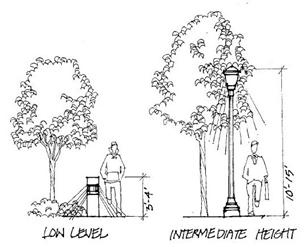
a. the maximum average maintained
foot-candles for all parking area lighting shall be three (3) foot-candles.
b. the minimum average maintained
foot-candles shall be one (1) foot-candle.
c. the maximum average maintained
foot-candles under a canopy shall be thirty-five (35) foot-candles.
Pedestrian-Scale
13.
Pedestrian connections and
customer entryways shall be reinforced with pedestrian scale lighting, bollard
lighting, accent lighting, or a combination thereof to aid in pedestrian
way-finding.
14.
Pedestrian areas shall be
illuminated to a minimum of one (1) foot-candle.
II. Aesthetic Character and Building Design
The
following standards and guidelines are intended to encourage an orderly and
logical pattern of commercial development that is easily recognized by local
residents, and that enhances the livability of the community. It is also the intent that these standards
and guidelines encourage forethought and consideration of a development's building
design and aesthetic characteristics in an effort to improve the imaginability
of such development. Building
architecture and attention to detail often defines the character of the
development, pedestrian experience of place, and the image of the community. The standards and guidelines are intended to
promote aesthetic character and building design elements for commercial
development to:
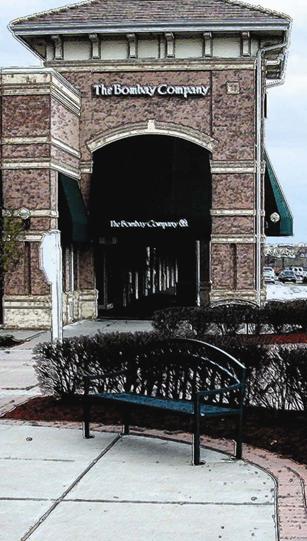
q
Create commercial developments which have visual interest and a
recognizable image as a distinct place.
q
Ensure a compatible architectural context with surrounding developments
and the community as a whole.
q
Enhance the streetscape by emphasizing corners of blocks, designating
points of entry, and differentiating new commercial areas in the community from
other types of activity centers, nodes, or areas.
q Improve, through
pedestrian-scale and context, the pedestrian experience within commercial
developments.

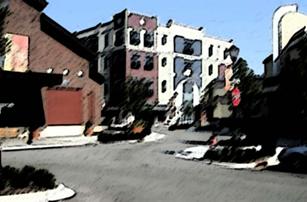
A. General Building Design
example showing consistent architectural style
Purpose and Intent:
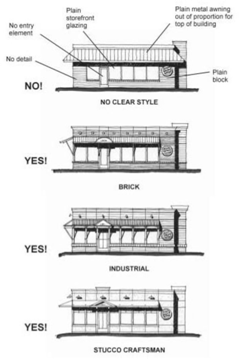
Attention
to detail and design contributes not only to the long-term value of a project,
but also to surrounding neighborhoods and the entire community. The use of different
architectural styles and building materials is intended to add variety to
buildings, but building design needs to also reflect the local and historic
character of
example showing articulation of the facade that
breaks up the building mass
The
intent of this design is to ensure that new development respects the general
character of adjacent neighborhoods through building scale, form, massing,
orientation, and spacing/proximity to adjacent uses.
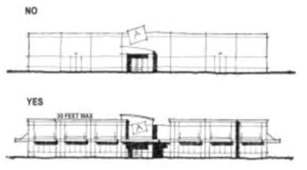
Standards
and Guidelines:
General Considerations
1. New buildings should strive for a contextual approach to design that
maintains compatibility and appropriateness with surrounding development and
that building design respect the use and intensity levels of
surrounding uses.
2. A
consistent architectural
style should be carried throughout the overall design of the development, that
each building of the development be designed as part of an overall composition,
and that buildings offer attractive and
inviting pedestrian-scaled features, spaces, and amenities.
B. Facades and Exterior Walls
Purpose and
Intent:
facade articulation also helps create visual
interest & improves the overall quality of the development
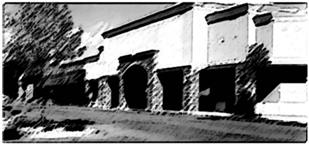
Variations
in building form, mass, orientation, and scale and fenestration patterns
through a combination of features, such as display windows, awnings, and entry
areas, help to subdivide and proportion facades. This variation, or articulation, creates
building frontages that are inviting, attractive, and in-scale to pedestrian
users and passersby. Often times this
articulation leads to improved visual quality and interest of a community’s
commercial areas, which in turn leads to improved consistency with the
community’s identity, character, and scale.

A
key to successful façade articulation is to consider “four-sided architecture,”
which means that all sides of a building should be equally attractive and
interesting. The rear or sides of
buildings often present an unattractive view of blank walls, loading areas,
storage areas, HVAC units, garbage receptacles, and other such features. Mitigation of those impacts through
architectural design and detail is recommended and must be considered as part
of the overall design of the development.
Standards
and Guidelines:
General Considerations
1. Back and sides of all buildings,
including pad site structures, shall include materials and design
characteristics consistent with those on the front façade.
2. Back or sides of buildings oriented
toward public streets or rights-of-way and adjacent residential development
shall provide visual interest through a combination of architectural detail and
landscape design.
3. All building elevations of a pad site
structure shall be finished with the same level of architectural detail and
quality of the primary structure and should reflect and/or complement adjacent
architectural detail.
Articulation
an
unsuccessful attempt at facade articulation
4. A
single, large, dominant building mass shall be avoided.
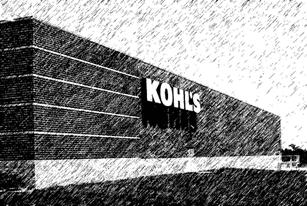
5. Facades that face public streets or
adjacent development shall be subdivided and proportioned using features such
as windows, entryways, arcades, arbors, awnings, trellises with vines,
recesses, projections, columns, pilasters, and similar elements, along no less
than sixty percent (60%) of the facade.
6. Out-lot buildings located along an
arterial or collector street shall be comprised of windows with clear, “vision”
glass between the height of three feet (3’) and eight feet (8’) above the
walkway grade for a minimum of fifty percent (50%) of any ground floor facade
facing the street; provided that, principal buildings are not subject to the
fifty percent (50%) transparency requirement, but where windows are appropriate
they are strongly encouraged.
7. Building
facades must include a repeating pattern that shall include no less than three
(3) of the elements listed below. At
least one (1) of these elements shall repeat horizontally. All elements shall repeat at intervals of no
more than thirty feet (30’), either horizontally or vertically.
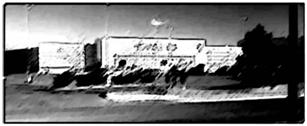
a. color change;
b. texture change;
c. material module change;
non-articulated
building facade (top) vs. articulated building facade (bottom)
d. expression
of architectural or structural bay through a change in plane no less than four
inches (4”) in width, such as an offset, reveal, or projecting rib; or
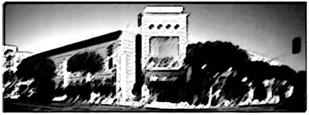
e. windows, display windows, or
architectural features if shown to display the same visual interest as windows.
8. Where principal buildings contain
additional stores which occupy less than twenty five thousand (25,000) square
feet of gross floor area, with separate, exterior customer entryways:
a. the street level facade of such stores
shall be transparent between the height of three feet (3’) and eight feet (8’)
above the walkway grade for no less than sixty percent (60%) of the horizontal
length of the building facade of such additional stores.
b. windows shall be recessed and should
include visually prominent sills, shutters, or other such forms of framing.
example showing a building composition having a
clearly defined base, middle, & top
9. All
buildings of the development shall have a composition that presents a
clearly-recognizable base, middle, and top, or a clearly-defined alternative
building composition.
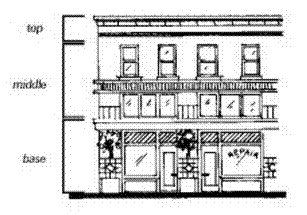
a. a recognizable "base" shall consist
of, but is not limited to:
(i) thicker walls, ledges, or sills;
(ii) integrally-textured materials such as
stone or other masonry;
(iii) integrally-colored and patterned
materials such as smooth-finished stone or tile;
(iv) lighter or darker colored materials,
mullions, or panels; or
(v) planters.
b. a recognizable "top" shall
consist of, but is not limited to:
entryways & rooflines that are visually
prominent & clearly defined help improve the visual quality of the
overall development
(i) cornice
treatments, other than just colored "stripes" or "bands,"
with integrally-textured materials such as stone or other masonry or differently
colored materials;
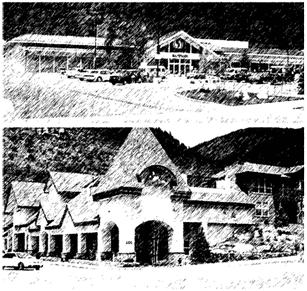
(ii) sloping roof with overhangs and
brackets;
(iii) stepped parapets; or
(iv) horizontal rhythms, such as openings and
articulations, shall logically align between levels.
C. Entryways and Rooflines
Purpose and
Intent:
Entryway
and roofline design elements and variation provide building articulation, add
visual interest, and help reduce the massive scale of large commercial
buildings. Entryway and roofline design
features should complement the character of adjacent development and
surrounding neighborhoods without detracting from such areas.
Multiple
entryways reduce walking distance from parking areas, facilitate greater pedestrian
and bicycle access from the public sidewalk, mitigate the effect of expansive
blank facades, and provide convenience where certain entryways offer access to
individual stores, or identified departments within a store.
Standards
and Guidelines:
General Considerations
1.
corner
entryways require special attention & provide opportunities to create
visual prominence that help define the character of the development
Entryways and rooflines of buildings
located on corner sites should be given special emphasis to highlight their
visual prominence.
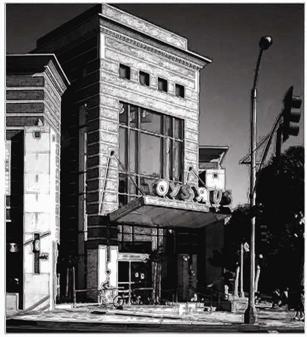
Entryways
1. Each principal commercial building
greater than fifty thousand (50,000) square feet of gross floor area shall
provide at least two (2) customer entryways, each of which shall be on separate
building facades that are oriented to a public street, parking area, or
pedestrian walkway.
2. Principal buildings that are smaller
than fifty thousand (50,000) square feet of gross floor area are encouraged to
provide multiple customer entryways.
3. The provision of multiple customer
entryways is recommended in the building design.
4. Primary entryways should be clearly
defined and distinguishable from the street and primary pedestrian walkways.
5. Principal entryway(s) shall be both
architecturally and functionally designed on the front facade of the building
facing the primary public street,,and such entryways shall be designed to
convey their prominence on the front facade.
leaving
rooftop equipment unscreened & on display for public view is
unacceptable
6. Where
additional stores will be located in the principal building, each such store
shall have at least one (1) prominent exterior customer entryway.
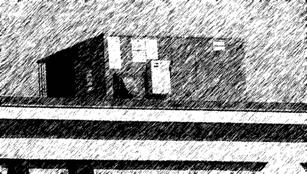
7. Some form of weather protection shall
be provided and should be combined with the method(s) used to achieve visual
prominence.
Rooflines:
8. Rooflines are encouraged to reflect
traditional roof configuration that are compatible with surrounding
architecture.
9. Variations (slopes) in rooflines that
add interest to and reduce the scale of large buildings are recommended,
however, three (3) rooflines or more should be avoided.
example
showing how rooftop equipment can be screened & remain out of view from
the public or adjacent properties
10. Overhanging
eaves are also encouraged as part of the roofline design.
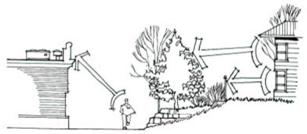
11. Buildings shall create a prominent edge
when viewed against the sky using varying roof forms and other architectural
elements.
12. Sloping roof elements are allowed but
not required.
13. The
building parapet shall be the primary means of
screening rooftop mechanical equipment and shall be required at a height that is as high, or higher, than the
rooftop equipment being screened.
14. Parapet
walls and other roof forms used for screening shall be architecturally
integrated into the overall building design.
Painting of rooftop equipment and erecting
fences are not acceptable methods of screening.
architectural details enhance the pedestrian
environment, improve the visual quality, & define the character of a
development
15. The number of vents and flues on rooftops shall be kept to a
minimum and located in a manner to not be visible.
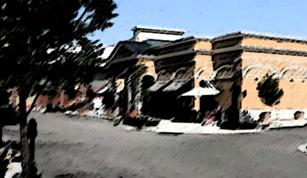
16. On sloped roof structures, vents and
flues shall be incorporated into architectural features to blend with the
roofing material.
17. Telecommunication transmission equipment
shall be blended in with the design of the roof, rather than being merely
attached to the roof-deck.
D. Architectural Details
Purpose and
Intent:
example showing architectural detail variety
Architectural
features and patterns within commercial developments provide visual interest at
the scale of the pedestrian, reduce massive aesthetic effects of large building
facades, and strengthen community character and imaginability.
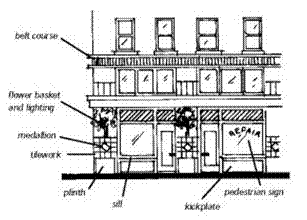
The
intent of incorporating and emphasizing architectural features in commercial
development is to promote pedestrian-scale and orientation to users of such
development, to create consistency throughout the development, and to enhance
the overall appearance of the community’s commercial areas.
Standards
and Guidelines:
General Considerations
1. Prototype “corporate architecture”
shall not be incorporated into the overall design of the development. Individual “corporate image” architectural
design elements and colors shall be incorporated only as secondary elements to
the development.
downspouts must be considered as part of the
overall building design & not as a “tacked-on” afterthought
2. Attention
to detail is recommended in developing a pedestrian-oriented environment at the
street level. It is also recommended
that a consistent and unifying architectural style, theme, or element be used
for all buildings of the development, however, a “
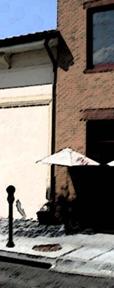
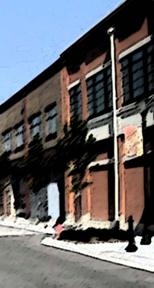
3. Building accessories and features, such
as trim types, moldings, shutters, roofing, cornices, pediments, foundations,
belt courses, and other characteristics, should draw on thematic precedents or
context of adjacent development, surrounding neighborhoods, and the overall
community.
4. Service area and mechanical equipment
shall be designed as an architectural feature of the building and entirely
screened from view.
5. Screening
shall be provided in a manner that is architecturally integral to the overall
appearance of the building.
6. Mechanical equipment shall not give the appearance of being “tacked on”
to the exterior building surface.
Specific
Considerations
7. The applicant is required to submit
evidence of the consistent and unifying architectural style, theme, or
element of the commercial development. This submittal may be in conjunction with the
color palette and building materials board submittal (discussed in the next
section).
8. The location of downspouts shall be
coordinated with the vertical elements (i.e., towers, columns, pilasters) and
the corners of buildings so that the eye is not drawn to or attracted by the
downspout and shall avoid a “tacked on” appearance. However, downspouts shall not be the only
vertical element or the only relief/projection on the building facade or placed
in the middle of large expanses of building wall.
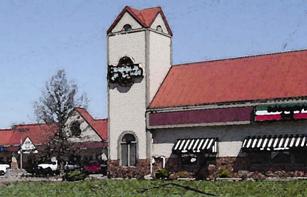
E. Materials and Colors
Purpose and
Intent:
 Exterior building materials and colors
comprise a significant part on the visual impact of an individual building and
overall commercial development. Quality
environments are created with variation and compatibility, and are more
attractive than monotonous or cheaply imitated styles. High-quality materials, a coordinated color
palette, and a variety of materials and/or colors are integral components in achieving
a quality development that fits into the overall community composition. Coordinating the materials and colors used in
a commercial development also promotes a sense of pedestrian-scale and
orientation within that development.
Exterior building materials and colors
comprise a significant part on the visual impact of an individual building and
overall commercial development. Quality
environments are created with variation and compatibility, and are more
attractive than monotonous or cheaply imitated styles. High-quality materials, a coordinated color
palette, and a variety of materials and/or colors are integral components in achieving
a quality development that fits into the overall community composition. Coordinating the materials and colors used in
a commercial development also promotes a sense of pedestrian-scale and
orientation within that development.
coordinated
building materials & colors improve the consistency & visual
quality of the development (top); uncoordinated building materials &
colors does the opposite (bottom)
Standards
and Guidelines:
General Considerations
1. A color palette and building materials
board shall be submitted as part of the development application. All buildings in the commercial development,
including pad site structures, shall be constructed of materials and colors
from the approved color palette and materials board in order to achieve unity
between all buildings in the development.
2. Materials and colors used to construct
any site amenity shall be similar in quality to the materials and colors of the
primary buildings and landscaping on the site.
use of
native building material, such as brick, helps visually tie the development
to the community & improves quality of the development
Materials
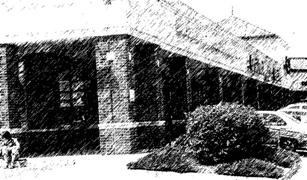
3. Exterior building material shall be
continued down to within nine inches (9”) of finished grade on any
elevation.
4. Predominant exterior building materials
shall be of high quality.
5. At least thirty percent (30%) of all
exterior building facades of each building within the commercial development shall
incorporate the use of native building materials, including limestone, brick,
or other natural stone.
Colors
6. Color schemes shall tie building
elements together, relate separate (free-standing) buildings within the same
development to each other, and shall be used to enhance the architectural form
of a building.
7. Intense, bright, black, metallic,
fluorescent, or otherwise garish colors shall be used sparingly as accents, and
such colors shall not be used as the predominant color on any facade or roof of
any building. Permitted sign areas shall
be excluded from this standard.
this
page intentionally left blank
Part Three: Infill and Redevelopment
The following standards and guidelines apply to all
commercial infill and redevelopment projects.
Infill and redevelopment, for the purpose of applying the standards and
guidelines, refers to any substantial restoration, remodel, addition, or any
other physical alteration to a commercial building or development that DOES NOT
involve demolition and reconstruction.
Projects involving demolition and reconstruction shall be subject to the
standards and guidelines for new construction
The following standards and guidelines have been
adapted to promote more flexibility with the intent of encouraging more
redevelopment of the community’s existing commercial areas. There may be certain instances where greater
flexibility is needed than what is provided by the standards and guidelines. All proposals will be evaluated with this
premise in mind and the City will work with all redevelopment proposals to help
ensure the overall intent of the standards and guidelines is met without
causing undue hardship on a property owner.
I. Site
Planning and Design
A. Natural
Features
1. Berms,
channels, swales, and similar man-made changes to the landscape shall be
designed and graded to be an integral part of the existing landscape and to
provide a smooth transition in changes of slope. The maximum slope of any man-made slope shall
be three-to-one (3:1).
2. Retaining
walls shall comply with the requirements for retaining walls set forth in Section
I (G) 35-38 of the standards and guidelines.
3. Vegetation
and plant material that exists on a site is encouraged to be used to satisfy
landscaping standards, including street tree requirements, provided that it
meets the size, variety, and locational requirements of Article 10 (Landscaping
and Screening) in the Land Development Code (LDC). As part of the site plan submittal, applicants shall submit an
existing tree survey and preservation plan to show compliance with the standards
and guidelines and the LDC.
B. Stormwater
and Site Drainage
1. Drainage patterns should be developed, including
the design and location of downspouts, to prevent concentrated surface drainage
from collecting on, and flowing across pedestrian walkways.
2. Detention basins and open drainage
areas visible from public rights-of-way and internal pedestrian walkways should
be incorporated into the site design as an attractive amenity or focal point,
such as a site entryway feature, a public green/open space, or a transition
technique with adjacent development.
Such areas are strongly encouraged to be designed as part of the site
landscaping network.
3. When fencing is provided for open drainage
and/or detention areas, it shall be a decorative material that coordinates with
other elements on the site, such as stone or brick columns. Fencing shall be open to allow views into and
across the featured detention area.
C. Streetscape
and Neighborhood Transitions
a
well-defined streetscape having landscaping, pedestrian amenities, building
transparency, & architectural details are keys to creating a
pedestrian-oriented development
1. A minimum of sixty percent (60%) of the
development site's street frontages should be occupied by the following:
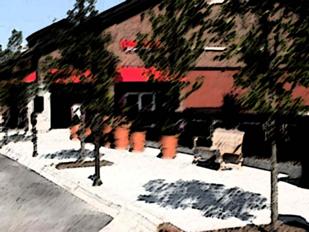
a. building
frontage;
b. decorative
architectural walls (no less than thirty inches [30”]);
c. landscaped
entryway signage or features;
d. focal
point; and/or
e. site
amenities.
f. the
remaining street frontage may be occupied by parking areas, as limited by those
requirements set forth in the standards and guidelines, or by breaks for
vehicle or pedestrian access.
2. All
kiosk-type buildings and structures shall be integrated with the overall
development, and shall be subject to the same requirements as all other
buildings within the development.
a. free-standing
kiosks and drive-up ATM structures should not be located along the primary
street frontage.
b. access
to a freestanding kiosk or drive-up ATM structure shall not be from the
adjacent public streets, but from drive aisles internal to the development.
c. free-standing
kiosks and drive-up ATM structures shall comply with the aesthetic character
and building design standards and guidelines of the standards and guidelines.
3. Architectural transitions, green/open space transitions,
and lesser intensive uses as transitions before employing more traditional
landscaping and screening transitions are encouraged for infill and
redevelopment projects.
4. Combination
of architectural transitions, green/open space transitions, and operational
compatibility standards should work to reduce the need for more intensive
landscaping and screening transitions.
Operational compatibility standards may apply to all, regardless of type
of transition technique used
5. When
fencing is provided along a property line, a decorative fencing material and
architectural accents shall be used which are compatible with the building
design.
6. Fencing
shall be designed in a manner to create variety such as staggering the fence
line and incorporating wrought-iron and masonry columns.
7. Pedestrian
connections, including bicycle access, into the development shall be clearly
defined and continuous.
D. Vehicular
Access and Parking Areas
1. A
detailed circulation plan, showing both vehicular and pedestrian patterns,
shall be submitted with all development applications that show compliance with
the standards and guidelines.
2. Unless
otherwise stated below, vehicular access and off-street parking areas shall
comply with Article 9 (Parking, Loading, and Access) of the LDC.
3. A
clear system of continuous main circulation drives shall be established to
carry the highest volumes of traffic within the site and to create an internal
vehicle circulation pattern that provides clear and direct access.
a. To
reduce pedestrian and vehicular conflicts in a development, main drive aisles
should not be located along the facades of buildings that contain primary
customer entryways.
b. where
the location of access points and the configuration of the main drive aisles
indicate that traffic volumes are lower and, consequently, pedestrian-vehicular
and vehicular-vehicular conflicts are less likely, more flexibility is
available in the location and design of internal drive aisles.
4. Connections
with adjacent nonresidential development shall be provided by siting a logical
array of minor access points with such development.
a. common
or shared service and delivery access shall be provided between adjacent
parcels and/or buildings.
b. access
easements ensure that adjacent parcels, or pad sites if applicable, have
adequate access in the event ownership patterns change over time should be
provided.
5. Where
applicable, shopping cart return stations shall be evenly distributed within
and between separate parking blocks.
6. Shopping
cart return stations
should incorporate landscaping, architectural features, or similar design
elements to draw attention to and soften the impact of stand-alone features
within parking areas.
7. Shopping
cart return stations shall be identified on the final plan.
8. Accessible
parking spaces shall be located adjacent to walkways and at building entryways
to minimize pedestrian-vehicle conflicts.
9. Where
a development proposes to exceed the minimum number of parking spaces required,
at least fifty percent (50%) of those additional spaces shall be constructed of
a permeable surface, as approved by the City Engineer. This requirement may be waived if additional
interior parking area landscaping is provided equal in area to the number of
permeable parking spaces otherwise required.
10. Parking
spaces may be permitted along main drive aisles and along the facades of
buildings featuring customer entryways, provided such parking does not impede
access for fire and emergency vehicle or access to and from the development
(i.e., driveways and turning movements).
example
showing a connection from the development (through the parking area) to the
public walkway & street
11. The use of angled parking spaces within parking
areas is discouraged and should be avoided to help minimize confusion
associated with one-way drive aisles and potential conflicts between vehicles.
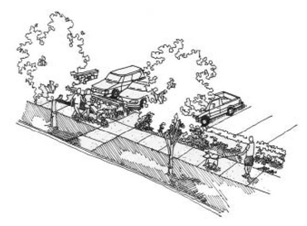
E. Pedestrian
Access and Amenities
1. A
detailed circulation plan, showing both pedestrian and vehicular patterns,
shall be submitted with all development applications that show compliance with
the standards and guidelines.
2. All
internal pedestrian walkways of the commercial development shall be a minimum of six
feet (6’) wide, but are encouraged to be at least eight feet (8’) wide.
3. Pedestrian
walkways shall include clear sight lines to building entryways.
4. Pedestrian
walkways shall be designed to provide direct access and connections to and
between the following:
a. customer
entryways to each commercial building, including pad site buildings;
b. any
walkways on adjacent properties that extend to the boundaries shared with the
development;
to
improve pedestrian safety & security, walkways must be clearly defined
where they cross a drive aisle or parking area
c. any public walkway system along the
perimeter streets adjacent to the development;
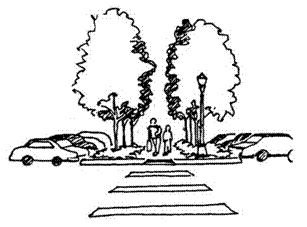
d. adjacent
land uses and developments, including but not limited to adjacent residential
developments, retail shopping centers, office buildings, or restaurants;
e. adjacent
public parks or other public or civic uses including but not limited to
schools, places of worship, public recreational facilities, or government
offices; and
f. site
amenities, focal points, or gathering places.
5. Pedestrian
walkways should be provided along the full length of any building, including
pad site structures, along any facade featuring a customer entryway and along
any facade abutting public parking areas.
Except where features such as arcades or entryways are part of the
facade, such walkways shall be separated from the facade of the building to
provide planting beds for foundation landscaping.
6. Pedestrian walkways shall provide weather protection
features, such as awnings, arcades, or roof overhangs, along the building facade and extending outward a minimum of thirty
feet (30’) from all customer
entryways.
7. Connections
between the internal pedestrian walkway network and any public sidewalk system
located along adjacent perimeter streets shall be provided at regular intervals
to provide easy access from the public sidewalk to the interior walkway
network.
example showing the incorporation of a pedestrian
amenity/focal point within the development
8. Where applicable, for
walls and fences greater than one hundred fifty feet (150’) in length, convenient
and inviting pedestrian access from the development to the surrounding
neighborhood shall be provided.
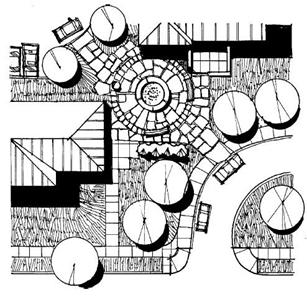
9. At
each point that the internal pedestrian walkway system crosses a parking area,
drive aisle, or driveway, the walkway or crosswalk shall be clearly marked
through the use of special paving or a change in paving materials distinguished
by their color, texture, or height to enhance pedestrian safety, comfort, and
wayfinding.
10.
11. All
site amenities within a development shall be an integral part of the overall
design and within easy walking distance of primary buildings, major tenants,
and any transit stops.
the provision of site furnishings enhances the
pedestrian environment of the development
12. Such features shall not be constructed
of materials that are inferior to the principal materials of the building and
landscape.
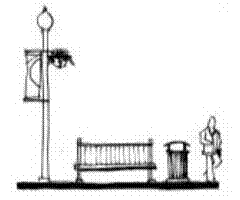
13. Site
amenities be in close proximity to the main entryway of the building to take
advantage of the flows of pedestrians, but other locations may be considered if
they are visible and easily accessible to the public.
14. Use
of site furnishings, such as benches, tables, bike racks, and other pedestrian
amenities shall be provided along main pedestrian walkways and at building
entryways, plazas, and other pedestrian areas.
15. Site
furnishings used shall not block pedestrian access to main walkways, open space
areas, and/or building entryways.
16. Bicycle
parking areas shall be located adjacent to customer entryways and shall comply
with Section 20-913(g) of the LDC.
example showing screening & buffering of a
service area to minimize impacts (noise, visual) on adjacent development
17. Pedestrian connections shall be
reinforced with pedestrian scale lighting, bollard lighting, accent lighting,
or a combination thereof to aid in pedestrian way-finding.

F. Outdoor
Storage, Sales, and Service Areas
1. Outdoor
storage, trash collection or compaction, loading docks, truck parking, utility
meters, HVAC equipment, and other service functions should be oriented toward
on-site service corridors so that the visual and acoustic impacts of these
functions are fully contained and out of view from adjacent properties and
public streets.
2. No
delivery, loading, trash removal or compaction, or other such operation shall
be permitted between the hours of 10:00 p.m. and 7:00 a.m. unless the development
submits evidence that sound barriers between all areas for such operations
effectively reduce noise emissions to a level of 45 db, as measured at the lot
line of any adjoining property.
3. When
it is not feasible to locate mechanical equipment and utility areas within a
building, such equipment and areas shall be located and screened in a manner so
as not to be visible or heard from adjoining properties.
4. When
landscaping is used for screening purposes, evergreen species shall be used as
the primary planting. Landscape
plantings for wall-mounted meters must be installed at a height of six feet
(6’).
5. Non-enclosed
areas for the storage and sale of seasonal inventory and/or vending machines
shall be permanently defined and screened with landscaping, walls, and/or
fences.
6. The
height of stored or displayed inventory shall not exceed the height of the
screening wall or fence. All fences
and/or walls shall comply with the requirements set forth in the standards and
guidelines.
7. Screening
materials, colors, and designs shall be the same as, or of equal quality to,
the materials, colors, and designs used for the primary building and
landscaping.
landscaping
must be coordinated with lighting & other site features to avoid
conflicts
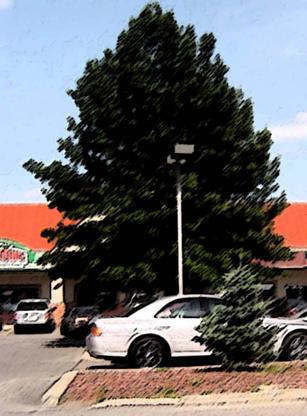
G. Landscaping,
Screening, and Walls
1. Unless
otherwise stated in the standards and guidelines, landscaping shall comply with
Article 10 (Landscaping and Screening) of the LDC. Submittal of a landscape plan is required per
Section 20-1001(d) of the LDC.
2. Each
area required to be landscaped shall be covered in live material. Live material includes trees, shrubs, ground
cover, flower beds, sod, and other living plant materials.
3. Areas
not covered in live material, not to exceed twenty-five percent (25%) of the
landscaped area, shall be covered by woody mulch, other organic or inorganic
mulch, rock mulch, or other natural materials other than exposed gravel and
aggregate rock.
4. Landscape
design and species shall be used to create visual continuity throughout the
development.
5. Plant
material shall consist of a mixture of evergreen and deciduous trees and shrubs
to provide visual interest and disease and pest resistance.
6. Plant
varieties shall provide year-round color, texture, and/or other special
interest and a minimum of one-third
(1/3) of the plantings shall be evergreen species. Ground covers shall be predominantly
evergreen varieties.
7. Required landscaping shall be
coordinated with the location of utilities, driveways, and traffic clearance
zones.
8. Landscaping shall be located an adequate distance
away from utility lines and easements to avoid damage when such lines are
repaired or replaced.
9. Adequate
provisions shall be made for irrigation in order to ensure that plants within
landscaped areas continue to be successful over the long-term.
10. Vegetation and plant material that exists on a site
prior to its development may be used to satisfy the landscaping standards
provided that it meets the size, variety, and locational requirements in
Article 10 (Landscaping and Screening) of the LDC.
12. Building
foundations planted with ornamental plant material, such as ornamental trees,
flowering shrubs and perennials, and ground covers are encouraged. Planting should be massed and scaled as
appropriate for the size and space it occupies.
landscaping along a building facade needs to be in
scale & appropriate to achieve the effect of “softening” the building
mass
a. whenever possible, landscaped areas
should be at least eight feet (8’) feet in depth. A depth of at least ten feet (10’) is
encouraged.
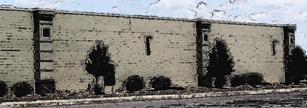
b. trees
should be planted, and may be clustered, at ratio of at least (1) tree per
forty linear feet (40’) of building frontage along any facade of a large retail
building that faces a public street, pedestrian walkway, or other public areas
(i.e., pedestrian plazas, patio/seating areas).
13. Driveways
to the development site shall be planted with ornamental trees, flowering
shrubs and perennials, and ground covers and shall be massed and scaled as
appropriate for the driveway size and space.
Landscaping shall "pull back" to open view lines into the site
and to create corner features.
14. Internal
pedestrian walkways shall feature adjoining landscaped areas that include
trees, shrubs, benches, flower beds, ground covers, or other such materials for
no less than fifty percent (50%) of the length of the walkway.
landscape strips within parking areas having
walkways must consider the pedestrian user & provide separation from
parked cars
15. One (1) canopy shade tree per fifty
linear feet (50’) of such walkway is required.
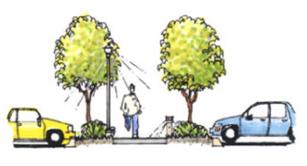
16. In
addition to the requirements in Article 10 (Landscaping and Screening) of the
LDC, the following requirements for interior
parking area landscaping shall apply:
a. landscape
islands and peninsulas shall occupy at least one-hundred sixty (160) square
feet of ground area.
b. landscape strips between parking rows shall
be a minimum of ten feet (10’) in width.
c. when incorporating pedestrian
walkways, such strips shall be a minimum of eighteen feet (18’) in width to
accommodate vehicular overhangs, the walk, lights, posts, and other
appurtenances.
d. landscape strips or medians shall
include medium to large deciduous trees at a minimum of one (1) tree every
thirty linear feet (30’), in addition to other parking area landscape
requirements.
e. primary
landscaping materials used in parking areas shall be trees, which provide shade
or are capable of providing shade at maturity.
f. shrubbery,
hedges, and other planting materials may be used to complement the tree
landscaping, but shall not be the sole means of landscaping.
g. effective
use of earth berms and existing topography is also encouraged as a component of
the landscaping plan.
h. individual
landscaped islands may be combined with other islands and/or landscaped strips
to provide larger landscaped areas within the parking area as long as the
minimum landscaping requirements (area and number) for interior parking area
landscaping are fulfilled.
17. Exterior shopping cart
storage areas located along a building facade shall be permanently defined and
screened with landscaping, walls, and/or other architectural features.
18. In
addition to the requirements in Article 10 (Landscaping and Screening) of the
LDC, parking areas
perimeter
parking areas adjacent to public streets must be appropriately landscaped
&/or screened to minimize visual impacts along the public r.o.w.
shall be landscaped and screened
from view of street rights-of-way with at least one
(1) of the following:
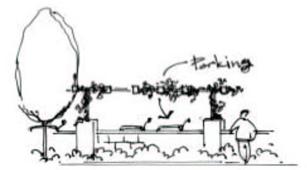
a. a solid masonry wall with a minimum height of two feet
(2’), a maximum height of three feet (3’), and a landscape planting area with a minimum
width of five feet (5’) located adjacent to the public right-of-way;
b. a berm with a minimum height of two feet
(2’), a maximum height of three feet (3’), and a maximum three-to-one (3:1)
slope. The berm shall be
located entirely on the property with the parking area and include a combination of
coniferous and deciduous tree and shrub plantings;
c. a
low continuous landscaped hedge at least three feet (3’) high, planted in a
triangular pattern so as to achieve full screening at maturity;
d. landscape
plantings consisting of eighty percent (80%) coniferous trees and eighty
percent (80%) evergreen shrubs and groundcovers; or
e. a
combination of any of these methods.
19. Perimeter
parking area landscaping may be satisfied by required landscaped bufferyards
[Article 10 (Landscaping and Screening) of the LDC] where the locational
requirements for a bufferyard overlap with the perimeter parking area
landscaping requirements.
20. Where
a bufferyard is required, that bufferyard(s) shall meet the requirements set
forth in Article 10 (Landscaping and Screening) of the LDC.
21. All
trash collection areas and mechanical and utility equipment shall be screened
and buffered as required in the standards (Outdoor Storage, Sales, and Services
Areas) and as set forth in Article 10 (Landscaping and Screening) of the LDC.
22. Fences
and walls shall be constructed of high quality materials, such as decorative
blocks, brick, stone, treated wood, and wrought iron.
23. When
fencing is provided along a property line, a decorative fencing material and
architectural accents shall be used which are compatible with the building
facades and shall be designed in a manner to create variety such as staggering
the fence line and incorporating “windows” or areas of transparency.
24. The
maximum length of a continuous, unbroken, and uninterrupted fence or
wall plane shall be one-hundred fifty feet (150’). Breaks shall be provided through the use of
columns, landscaping pockets, transparent sections, and/or a change to
different materials. Breaks in the
length of a fence shall be made to provide for required pedestrian connections
to the perimeter of a site or to adjacent development.
25. Fences and walls shall be set back at least six feet (6’)
from the back edge of an adjacent pedestrian walkway, and such setback area
shall be landscaped with turf, groundcovers, shrubs, and trees, using a variety
of species to provide seasonal color and plant variety. Fencing shall not exclude use of hydrants or fire
department connections or hydrants.
26. Retaining
walls shall not exceed five feet (5’) in height from the finished grade.
a terracing
shall be limited to four (4) tiers. The
width of the terrace between any two (2) five foot (5’) retaining walls shall
be a minimum of four feet (4’) with a maximum slope of three-to-one (3:1). Terraces created between retaining walls
shall be permanently landscaped.
b retaining
walls shall be stacked with natural stone, faced with stone or earth-colored
materials, or faced with a material compatible with the primary building
materials. Railroad ties, timber, and
gabion-type retaining walls are prohibited.
H. Lighting
and Security
1. Unless otherwise stated in the standards and
guidelines, lighting shall comply with Section 20-1104 (Outdoor Lighting) of
the LDC. Submittal of an outdoor
lighting plan is required whenever site
plan review is required.
2. Building-mounted
lighting shall be used to highlight specific architectural features or primary
customer or building entryways.
3. Building-mounted
neon lighting is allowed only when recessed, or contained in a cap or
architectural reveal.
4. Outlining
the roof or building in neon tubing is prohibited.
connections having lighting scaled to the
pedestrian improves feelings of safety & security, & enhances the
overall quality of the development
5. The lighting of parking
areas with high level light standards is required.
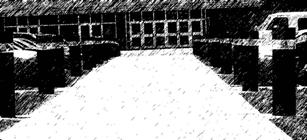
6. Parking area illumination shall be
accomplished with individual light poles and fixtures.
7. Building-mounted
fixtures are not permitted as a method of parking area illumination, but may be
acceptable for service and loading areas.
a. parking area light poles/fixtures of the
same style, height, color, and intensity of lighting shall be maintained
throughout the development area.
b. Varying styles of fixtures may be
permitted if it is demonstrated that the styles contribute to an overall theme
for the area.
c. the maximum pole height in a
commercial center shall be thirty-five feet (35’).
d. The maximum pole height for an
individual site development shall be twenty-five feet (25’).
8. Luminaire
fixtures shall be arranged to provide uniform illumination throughout the
parking area.
a. the
maximum average maintained foot-candles for all parking area lighting shall be
three (3) foot-candles.
b. the
minimum average maintained foot-candles shall be one (1) foot-candle.
c. the
maximum average maintained foot-candles under a canopy shall be thirty-five
(35) foot-candles.
9. Pedestrian
connections and customer entryways shall be reinforced with pedestrian scale
lighting, bollard lighting, accent lighting, or a combination thereof to aid in
pedestrians way-finding. Pedestrian
areas shall be illuminated to a minimum of one (1) foot-candle.
II. Aesthetic
Character and Building Design
A. Facades
and Exterior Walls
1. Back
and sides of all buildings, including pad site structures, shall include
materials and design characteristics consistent with those on the front
facade.
2. Back
or sides of buildings oriented toward public streets or rights-of-way and
adjacent residential development shall provide visual interest through a
combination of architectural detail and landscape design.
3. All
building elevations of a pad site structure shall be finished with the same
level of architectural detail and quality of the primary structure and should
reflect and/or complement adjacent architectural detail.
4. A
single, large, dominant building mass shall be avoided.
5. Facades
that face public streets or adjacent development shall be subdivided and
proportioned using features such as windows, entryways, arcades, arbors,
awnings, trellises with vines, recesses, projections, columns, pilasters, and similar
elements, along no less than sixty percent (60%) of the facade.
a. out-lot
buildings located along an arterial or collector street comprised of windows
with clear, “vision” glass between the height of three feet (3’) and eight feet
(8’) above the walkway grade for a minimum of fifty percent (50%) of any ground
floor facade facing the street is strongly encouraged.
b. principal
buildings are not subject to fifty percent (50%) transparency, but where
windows are appropriate they are strongly encouraged.
6. Building
facades must include a repeating pattern that shall include no less than three
(3) of the elements listed below. At
least one (1) of these elements shall repeat horizontally. All elements shall repeat at intervals of no
more than thirty feet (30’), either horizontally or vertically.
a. color
change;
b. texture
change;
c. material
module change;
d. expression
of architectural or structural bay through a change in plane no less than four
inches (4”) in width, such as an offset, reveal, or projecting rib; or
e. windows,
display windows, or architectural features if shown to display the same visual
interest as windows.
7. Where
principal buildings contain additional stores which occupy less than twenty
five thousand (25,000) square feet of gross floor area, with separate, exterior
customer entryways:
a. the
street level facade of such stores shall be transparent between the height of
three feet (3’) and eight feet (8’) above the walkway grade for no less than
sixty percent (60%) of the horizontal length of the building facade of such
additional stores.
b. windows
shall be recessed and should include visually prominent sills, shutters, or
other such forms of framing.
8. Building
form that presents a clearly-recognizable base, middle, and top, or a clearly-defined
alternative building composition is strongly encouraged.
B. Entryways
and Rooflines
1. Each
principal commercial building of a development is strongly encouraged to
provide at least two (2) customer entryways, each of which shall be on separate
building facades that are oriented to a public street, parking area, or
pedestrian walkway.
2. Principal
entryway(s) shall be both architecturally and functionally designed on the
front facade of the building facing the primary public street.
3. Principal
entryways shall be designed to convey their prominence on the front facade.
4. Where
additional stores will be located in the principal building, each such store
shall have at least one (1) prominent exterior customer entryway.
5. Some
form of weather protection shall be provided and should be combined with the
method(s) used to achieve visual prominence.
6. Buildings
shall create a prominent edge when viewed against the sky using varying roof
forms and other architectural elements.
7. Sloping
roof elements are allowed but not required.
8. The building parapet shall be the primary means of
screening rooftop mechanical equipment and shall be required at a height that is as high, or higher, than the
rooftop equipment being screened.
9. Parapet walls and other roof forms used
for screening shall be architecturally integrated into the overall building
design.
10. Painting of rooftop equipment and erecting fences
are not acceptable methods of screening.
11. Vents,
flues, telecommunication transmission equipment, and other rooftop equipment shall be
incorporated into architectural features to blend with the roof design and
roofing material, rather than being merely attached to the roof.
C. Architectural
Details
1. Prototype
“corporate architecture” and individual “corporate image” architectural design
elements and colors shall be incorporated only as secondary elements to the
development.
2. Service
area and mechanical equipment shall be designed as an architectural feature of
the building and entirely screened from view.
3. Screening shall be provided in a manner that
is architecturally integral to the overall appearance of the building.
4. Mechanical equipment shall not give the appearance
of being “tacked on” to the exterior building surface.
5. The
applicant is required to submit evidence of a consistent and unifying architectural style, theme, or element for the development. This submittal may be in conjunction with the
color palette and building materials board submittal (discussed in the next
section).
6. The
location of downspouts shall be coordinated with the vertical elements (i.e.,
towers, columns, pilasters) and the corners of buildings so that the eye is not
drawn to or attracted by the downspout.
7. Downspouts
shall avoid a “tacked on” appearance.
However, downspouts shall not be the only vertical element or the only
relief/projection on the building facade or placed in the middle of large
expanses of building wall.
D. Materials
and Colors
1. A
color palette and building materials board shall be submitted as part of the
development application. All buildings
in the commercial development, including pad site structures, shall be
constructed of materials and colors from the approved color palette and
materials board in order to achieve unity between all buildings in the
development.
2. Materials
and colors used to construct any site amenity shall be similar in quality to
the materials and colors of the primary buildings and landscaping on the site.
3. Exterior
building material shall be continued down to within nine inches (9”) of
finished grade on any elevation.
4. Predominant
exterior building materials shall be of high quality.
5. It
is strongly encouraged that at least thirty percent (30%) of all exterior
building facades of each building within the development incorporate the use of
native building materials, including limestone, brick, or other natural stone.
6. Color
schemes shall tie building elements together, relate separate (free-standing)
buildings within the same development to each other, and shall be used to
enhance the architectural form of a building.
7. Intense,
bright, black, metallic, fluorescent, or otherwise garish colors shall be used
sparingly as accents, and such colors shall not be used as the predominant
color on any facade or roof of any building.
Permitted sign areas shall be excluded from this standard.
this
page intentionally left blank